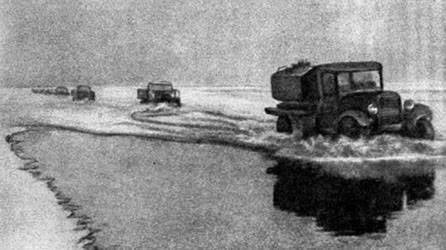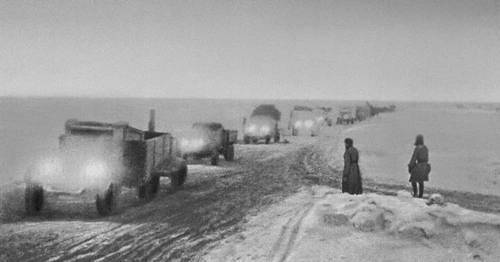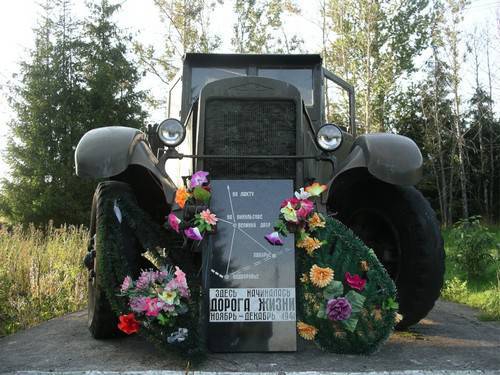"The Road of Life" of besieged Leningrad

The only way besides ineffective aviation, for the evacuation of people from the besieged Leningrad, as well as for delivering food and military supplies back to the city in September-November 1941, there was Lake Ladoga, along which the ships of Ladoga cruised daily flotilla. However, it was obvious that before the onset of cold weather the German ring around the city would not be broken and in order to avoid the possibility of a complete blockade of Leningrad in the winter, it was necessary to find a way out as soon as possible. And such a way was found - this is the idea of creating ice crossings over Lake Ladoga, which later became known as the "Road of Life".
Many at first were rather skeptical of this idea, since they doubted that the ice would be able to carry the huge amount of cargo that they were going to ship through it. The Germans didn’t believe it either; they literally wrote the following in the leaflets scattered over Leningrad: “It’s impossible to supply the millionth population and army on the ice of Lake Ladoga”. However, to leave the three millionth city for the whole winter without supplies actually meant to doom its inhabitants to certain death and work on creating an ice crossing began. First, as a result of the titanic work of the Office of Logistics on the Leningrad Front, in less than a month, all the information available at that time on the transport of heavy loads on ice, as well as on the ice regime specifically of Lake Ladoga, was collected. As a result of these studies, the most suitable route for the crossing was the route New Ladoga - Chernoushevo - Lemassary - Kobona. On November 20, 1941, along the “Road of Life”, went the first horse-drawn carts, and a day later the famous GAZ-AA (lorry carts).

Despite the fact that it seemed that a huge theoretical preparation was carried out before creating the ice crossing, and besides, the 1941-1942 winter was very harsh and snowy, Lake Ladoga presented an unpleasant surprise. Very often it happened that a convoy of trucks loaded to capacity without any problems overcame the route, and the light machine following them fell through the ice. And it fell instantly, leaving no chance for people inside. This was due to the resonance phenomenon that was little studied at that time, or rather the flexural-gravity wave, to avoid which, all cars were ordered to follow at a strictly defined speed. After several such cases, the crossing got its second, more terrible name - “The Road of Death”.
The Germans did not forget about the “Road of Life”, regularly making air raids and artillery strikes on the lake, since their position was literally a few kilometers from the crossing. Therefore, when driving at night, many lorry drivers drove, without turning on the headlights, to at least somehow protect themselves against air strikes, it can be said that they were driving almost blindly. The drivers who worked on the “Road of Life” are generally worthy of a separate stories. They carried out with a terrible cold (most of them even went with the doors open so that they could jump in case of an ice flop) on 12 hours behind the wheel, making 5-7 flights throughout the day across Lake Ladoga, but they received poor rations, as well as simple blockade. However, none of them complained, because everyone understood how important their work was for the blockade and soldiers defending Leningrad.

The 1942-1943 ice crossing in the winter of the year was even more dangerous than a year earlier. As a result of a mild winter with frequent thaws, the ice was often cracked, and this led to an even greater number of failures, but the “Road of Life” even in such conditions continued to operate until April 24, 1943, that is, even after the blockade of Leningrad was lifted. In just two years, according to official statistics, over 640 thousand people were evacuated across the ice of Lake Ladoga, thousands of tons of various cargoes were delivered to the city of 575, and about 300 thousand soldiers and officers were transported to the Leningrad front. That is, it is obvious that the creation of the “Road of Life” in November 1941 of the year was one of the key factors that, at least minimally, provided food for the city’s residents and the Leningrad defense fighters, and this in turn directly affected the overall outcome of the Leningrad battle.
Information